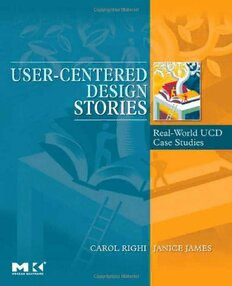
User-Centered Design Stories: Real-World UCD Case Studies (Interactive Technologies) PDF
688 Pages·2007·11.57 MB·English
Most books are stored in the elastic cloud where traffic is expensive. For this reason, we have a limit on daily download.
Preview User-Centered Design Stories: Real-World UCD Case Studies (Interactive Technologies)
Description:
Intended for both the student and the practitioner, this is the first user-centered design casebook. It follows the Harvard Case study method, where the reader is placed in the role of the decision-maker in a real-life professional situation. In this book, the reader is asked to perform analysis of dozens of UCD work situations and propose solutions for the problem set. The problems posed in the cases cover a wide variety of key tasks and issues facing practitioners today, including those that are related to organizational/managerial topics, UCD methods and processes, and technical/ project issues. The benefit of the casebook and its organization is that it offers the new practitioner (as well as experienced practitioners working in new settings) the valuable practice in decision-making that one cannot get by reading a book or attending a seminar. *The first User-Centered Design Casebook, with cases covering the key tasks and issues facing UCD practitioners today. *Each chapter based on real world cases with complex problems, giving readers as close to a real-world experience as possible. * Offers "the things you don't learn in school," such as innovative and hybrid solutions that were actually used on the problems discussed. Read more... Justifying, developing, and starting a UCD Program; Raising awareness and educating others in the work environment; Hiring UCD professionals; Estimating and pricing a UCD effort; Selecting appropriate user research methodologies; Selecting appropriate evaluation methodologies; Designing a user iterface; Designing user help; Web site information architecture; Addressing accessibility issues (i.e. designing for those with disabilities); Applying UCD to middleware/products with no obvious user interface; Managing the politics of UCD in the Workplace; Recruiting for a UCD effort; Developing and delivering UCD training; Interplay of the business model/business requirements and user requirements; Cost-Justifying a UCD effort
See more
The list of books you might like
Most books are stored in the elastic cloud where traffic is expensive. For this reason, we have a limit on daily download.
